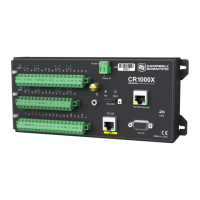is available for user-allocated data tables. This memory is given lowest priority in SRAM
memory allocation.
l Communication Memory 1: Memory used for construction and temporary storage of
PakBus packets.
l Communication Memory 2: Memory used to store the list of known nodes and routes to
nodes. Routers use more memory than leaf nodes because routes store information about
other routers in the network. You can increase the Communication Allocation field in
Device Configuration Utility to increase this memory allocation.
l USR drive: Optionally allocated. Holds image files. Holds a copy of final-data memory
when TableFile() instruction used. Provides memory for FileRead() and
FileWrite() operations. Managed in File Control. Status reported in Status table fields
USRDriveSize and USRDriveFree.
5.3 Flash memory
The datalogger operating system is stored in a separate section of flash memory. To update the
operating system, see Updating the operating system (p. 109).
5.4 Serial flash memory
Serial flash memory holds the CPU drive, web page, and datalogger settings. Because flash
memory has a limited number of write/erase cycles, care must be taken to avoid continuously
writing to files on the CPU drive.
5.4.1 Data memory
Measurement data is primarily stored in data tables within SRAM. Data is usually erased from this
area when a program is sent to the datalogger.
During data table initialization, memory sectors are assigned to each data table according to the
parameters set in the program. Program options that affect the allocation of memory include the
5. Data memory 39

